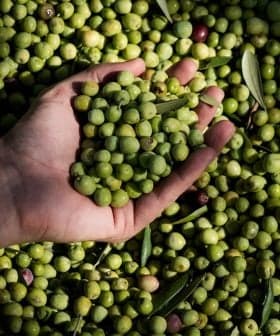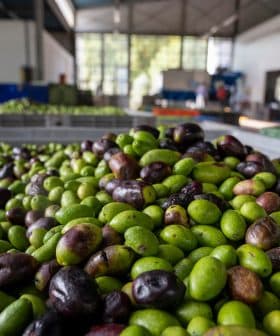Oleacein: The Promising Phenolic Compound in Extra Virgin Olive Oil

Oleacein, a phenolic compound found in extra virgin olive oil, has antioxidant, anti-inflammatory, and potential anti-atherosclerotic properties that can significantly impact human health. Research shows that oleacein is one of the most abundant and chemically active phenolics in virgin olive oils, with the potential to improve metabolic health, protect the brain, and reduce inflammation in the body. Studies are ongoing to further understand oleacein’s absorption, metabolism, and bioavailability, and consumers interested in its benefits should look for high-quality olive oils with a high polyphenol count.
Among the many beneficial components of extra virgin olive oil, few are as promising and as little known as oleacein.
Initial research shows that the antioxidant, anti-inflammatory and potential anti-atherosclerotic properties of this phenolic compound may significantly impact human health.
Most health-conscious consumers are familiar with antioxidants, including hydroxytyrosol or flavonoids, due to decades of research on the compounds.
See Also:Olive Oil BasicsDue to its unique nature, research on oleacein began relatively recently. It was initially discovered and isolated in olive leaves, and its role in extra virgin olive oil was not immediately evident.
According to the researchers studying this molecule, oleacein is both one of the most abundant phenolics in virgin olive oils and one of the most chemically active.
Where does oleacein come from?
Oleacein is found almost exclusively in high-quality, fresh extra-virgin olive oil and results from transformations that occur during olive processing.
“Oleacein originates from the hydrolysis of the glycoside oleuropein,” Maria de Fátima Paiva-Martins, researcher at the University of Porto’s chemistry and biochemistry department, in Portugal, told Olive Oil Times.
Hydrolysis is a chemical reaction in which complex substances, such as proteins or fats, are split into simpler ones.
During the olive crushing process, oleuropein undergoes enzymatic hydrolysis, which produces aglycone, a more fat-soluble molecule. “This aglycone then transforms into oleacein,” Fátima Paiva-Martins said.
Where hydroxytyrosol and oleacein meet
One of the most interesting components of extra virgin olive oil, hydroxytyrosol, is not present in high amounts in olive oil.
Instead, it is a metabolite, a byproduct that appears in the human body after ingesting compounds, including oleacein.
“Hydroxytyrosol is highly hydrophilic, so it doesn’t remain in the olive oil. What we find in higher concentrations are its esters, like oleacein, which later hydrolyze into hydroxytyrosol after digestion,” Fátima Paiva-Martins said.
See Also:Study Shows Potential Health Benefits of Hydroxytyrosol in Olive OilExtra virgin olive oil’s phenol esters are compounds formed when a phenol (such as hydroxytyrosol) reacts with specific acid molecules.
“Oleacein is a biphenolic compound. It contains two phenolic hydroxyl groups, which makes it an especially powerful antioxidant,” said Prokopios Magiatis, an associate professor of pharmacognosy at the National and Kapodistrian University of Athens.
“It’s an ester of hydroxytyrosol, but unlike hydroxytyrosol, which is water-soluble, oleacein is amphiphilic. It can dissolve in both water and fat,” he added.
Oleacein’s vast potential in health
Oleacein’s dual solubility may help explain its effectiveness inside the human body, as it allows broad interaction with both lipid and aqueous environments.
Because of its structure, oleacein can integrate into the body’s lipid particles, including low-density lipoproteins (LDL), often known as “bad cholesterol.” Once incorporated, it might offer a protective shield.
“Oleacein can be incorporated in LDL particles and protect them from oxidation,” Magiatis explained. “And that is crucial, because the oxidation of LDL cholesterol is one of the first steps in the formation of arterial plaques.”
Oleacein also shows promising anti-inflammatory properties. Its mechanisms are quite different from those of better-known compounds, such as oleocanthal, which is also found in extra virgin olive oil.
“Oleacein does not inhibit COX,” Magiatis remarked, referring to the cyclooxygenase enzymes that oleocanthal targets, and which are responsible for producing prostaglandins, molecules that promote inflammation and pain.
See Also:Biophenols in Extra Virgin Olive Oil Linked to Improved Outcomes in Obesity and Prediabetes“But oleacein reduces the expression of TNF‑α and certain interleukins. These are cytokines that drive the inflammatory response,” Magiatis said.
Cytokines are small proteins that act as messengers between cells in the body. Therefore, oleacein modulates the body’s sensitivity and reaction to inflammatory molecules.
“It can also suppress enzymes involved in inflammation. So we’re seeing a complementary mode of action,” Magiatis said.
Oleacein’s health impacts may also extend to metabolism.
According to a clinical study published in 2024, 17 pre-diabetic adults consumed extra virgin olive oil rich in oleacein and oleocanthal.
The results, compared to a standard olive oil, were significant, as inflammatory cytokines dropped, antioxidant status improved, lipid oxidation decreased, and both body mass index and glucose significantly enhanced.
The researchers concluded that oleacein-rich olive oil can contribute to improved metabolic health in individuals at high risk.
Oleacein in brain health research
Given its broad implications in the body’s chemistry, research has recently focused on how oleacein impacts brain function.
Several neurology studies in cell cultures and animal models have demonstrated that oleacein might play a role in protecting the brain.
Magiatis’s lab, in collaboration with researchers at the University of Valladolid in Spain, tested oleacein in an animal model of multiple sclerosis.
See Also:Why Extra Virgin Olive Oil Is Linked with Lower Dementia Risk, Better Brain Health“It was very clear: oleacein protected the brain. We saw anti-inflammatory activity in nerve cells and strong antioxidant effects at the site of the damage,” Magiatis explained.
That preclinical study laid the groundwork for a human clinical trial in patients with multiple sclerosis, which has now been completed and is awaiting publication.
Meanwhile, other groups are exploring oleacein’s neuroprotective potential.
A 2023 paper demonstrated that oleacein acts as a TrkB receptor agonist, thereby promoting the expression of brain-derived neurotrophic factor, a key protein involved in neuroplasticity.
The authors noted reduced depressive behavior and inflammation in mice treated with oleacein.
The journey has just begun
While oleacein is at the forefront of research on extra virgin olive oil’s most active phenols, Magiatis and Fátima Paiva-Martins said research is still in its early stages.
Much of what is known today about oleacein’s impact comes from lab and animal models, and although human studies are emerging, much remains to be explored.
“The biological effects attributed to olive oil consumption are essentially due to the intake of lipophilic derivatives of oleuropein, such as oleacein,” Fátima Paiva-Martins noted.
“The metabolites responsible for oleacein’s biological activity have not yet been fully identified or characterized,” the researcher cautioned. “We know hydroxytyrosol metabolites play a role, but the full picture remains unknown.”
“Oleacein is a highly reactive molecule and can form adducts with proteins, though the impact of this reactivity on its biological activity and the systemic effects observed after olive oil consumption is still not fully understood,” she added.
Research is ongoing, focusing on the complexity of oleacein.
“We’re in a good place,” Magiatis said. “We have made progress, and soon new research will clarify key aspects such as oleacein’s absorption, metabolism and bioavailability.”
How to select EVOO high in oleacein
Current knowledge about oleacein suggests that consumers interested in its benefits should look for high-quality olive oils with a high polyphenol count.
Freshly produced olive oils that provoke a slight cough or a peppery kick are good candidates for delivering oleacein, as such sensory irritation is often a sign of both oleacein and oleocanthal.
Besides storing extra virgin olive oil in a cool, dark place, research suggests that oleacein levels can be well preserved at wine-cellar temperatures (12 to 14 °C).
According to Magiatis, what makes the difference in the healthy impact of extra virgin olive oil is not a single significant component, but rather the whole product.
“In my personal view, olive oil is the best way to get those healthy compounds in your body,” he said. “It is natural, balanced, and it comes with dozens of other compounds that work together. Nothing can compare to that.”
Know the Basics
Things to know about olive oil, from the Olive Oil Times Education Lab.
Extra virgin olive oil (EVOO) is simply juice extracted from olives without any industrial processing or additives. It must be bitter, fruity and pungent — and free of defects.
There are hundreds of olive varieties used to make oils with unique sensory profiles, just as many varieties of grapes are used in wines. An EVOO can be made with just one variety (monovarietal) or several (blend).
Extra virgin olive oil contains healthy phenolic compounds. Substituting a mere two tablespoons of EVOO per day instead of less healthy fats has been shown to improve health.
Producing high-quality extra virgin olive oil is an exceptionally difficult and costly task. Harvesting olives earlier retains more nutrients and extends shelf life, but the yield is far less than that of fully ripe olives that have lost much of their healthy compounds.









